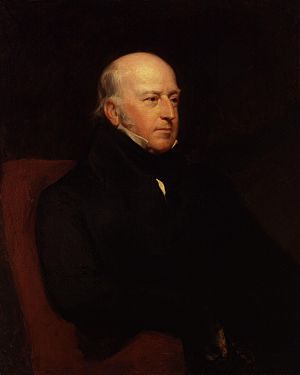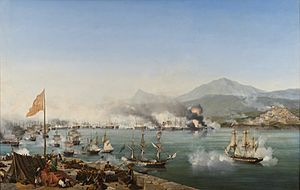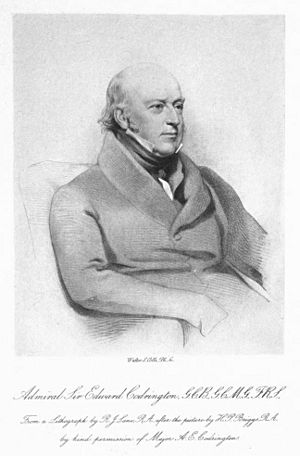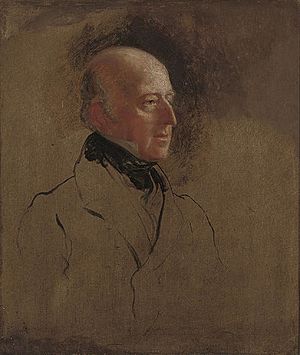Edward Codrington facts for kids
Quick facts for kids
Sir Edward Codrington
|
|
|---|---|

Sir Edward Codrington by Henry Perronet Briggs
|
|
| Born | 27 April 1770 Dodington, England |
| Died | 28 April 1851 (aged 81) London, England |
| Allegiance | |
| Service/ |
|
| Rank | Admiral |
| Commands held | Portsmouth Command Mediterranean Fleet HMS Orion HMS Druid HMS Babet |
| Battles/wars | French Revolutionary Wars |
| Awards | Knight Grand Cross of the Order of the Bath Order of St. George, 2nd Class (Russia) |
| Relations | General Sir William Codrington (son) Admiral of the Fleet Sir Henry Codrington (son) |
| Signature | |
Sir Edward Codrington (27 April 1770 – 28 April 1851) was a famous British admiral. He played important roles in major naval battles. These included the Battle of Trafalgar and the Battle of Navarino.
Contents
Edward Codrington came from a family with a long history in the military. He was the youngest of three brothers. His uncle, Mr. Bethell, taught him. He also spent a short time at Harrow.
In July 1783, Edward joined the Royal Navy. He served in different parts of the world. He was promoted to lieutenant in May 1793. He became a signal lieutenant on the flagship of the Channel fleet. This was at the start of the French Revolutionary Wars. He served on the ship HMS Queen Charlotte. This ship was part of the operations that led to the battle of the Glorious First of June.
After this battle, he was promoted to commander in October 1794. In April 1795, he became a Post-Captain. He took command of the 22-gun Babet. From this ship, he watched the Battle of Groix. Later, he commanded the frigate Druid. In January 1797, his ship Druid, along with two others, captured a French frigate. This French ship was carrying soldiers to Ireland.
Edward Codrington married Jane Hall in December 1802. They had three sons and three daughters. He did not have a ship for some years after his marriage. This changed when the Peace of Amiens ended in 1803.
Fighting in Major Wars
When fighting with France started again, Codrington was given command of the ship of the line HMS Orion. This was in the spring of 1805. His ship joined Admiral Nelson's fleet. They were blocking the French and Spanish fleets off Cadiz.
The Battle of Trafalgar
Codrington and Orion fought in the Battle of Trafalgar on 21 October 1805. Orion was at the back of the northern group of ships. It took two hours for them to reach the main battle. Once there, Codrington focused on attacking a French ship called Swiftsure. He forced this ship to surrender.
He then attacked the Spanish flagship Principe de Asturias. He did not capture it. Next, he moved to the Intrepide. Orion, with other ships, damaged Intrepide's masts. They sailed around it, firing continuously. Finally, Intrepide surrendered.
Helping Spain and the War of 1812
For several years, Codrington fought alongside the Spanish against the French. He commanded a group of ships. They attacked French shipping and raided coastal areas. He also took part in the difficult Walcheren expedition in 1809.
In 1811, he helped the Spanish who were being attacked at Tarragona. The French Army of Aragon was besieging the city. Codrington worked hard to bring 6,300 Spanish soldiers and 291 artillerymen as help. He spent many nights guiding cannon attacks against the enemy. When the city fell, he rescued over 600 people from the beach. This was done under enemy fire. He also helped reunite mothers and babies who got separated during the evacuation.
Codrington was promoted to rear admiral on 4 June 1814. This was while he was serving off North America. He was captain of the fleet for Vice Admiral Sir Alexander Cochrane. They were involved in operations against Washington, Baltimore, and New Orleans during the War of 1812. For his service, he was made a Knight Commander of the Order of the Bath in 1815. He became a vice admiral on 10 July 1821. He was also chosen as a Fellow of the Royal Society in February 1822.
The Greek War of Independence
In December 1826, Codrington became the Commander-in-Chief of the Mediterranean Fleet. He sailed on 1 February 1827. He was involved in the difficult duties of the Greek War of Independence. This war had caused a lot of trouble in Greece. His orders were to help find a peaceful solution for Greece.
On 20 October 1827, Codrington led a combined British, French, and Russian fleet. They destroyed the Turkish and Egyptian fleet at the Battle of Navarino. This was a very important naval victory.
After the battle, Codrington went to Malta to repair his ships. He stayed there until May 1828. Then he sailed to meet his French and Russian partners. They tried to get Ibrahim Pasha to leave the Morea peninsula peacefully. Ibrahim Pasha caused problems. On 25 July, the three admirals agreed that Codrington should go to Alexandria. He was to ask Ibrahim's father, Mehemet Ali, to recall him. Codrington's presence in Alexandria led to a treaty on 6 August 1828. This treaty arranged for the evacuation of the Morea. His services were recognized with the Grand Cross of the Bath award.
Later Life and Legacy
After returning home, Codrington spent some time defending his actions. He also enjoyed leisure time abroad. In 1831, he commanded a training group of ships in the Channel. He became a full admiral on 10 January 1837.
He was elected a Member of Parliament for Devonport in 1832. He served in Parliament until 1839. From November 1839 to December 1842, he was Commander-in-Chief, Portsmouth.
Codrington died in London on 28 April 1851. He had two sons who also became important military figures. Sir William Codrington (1804–1884) was a commander in the Crimean War. Sir Henry Codrington (1808–1877) was a naval officer who became an Admiral of the Fleet.
A third son, Edward Codrington, was a midshipman. He died in 1821 or 1822 in the Mediterranean. His boat overturned in a storm, and he drowned.
Codrington was first buried in St Peter's Church, Eaton Square. In 1954, his remains were moved to Brookwood Cemetery in Surrey. There are plaques in his memory at St Paul's Cathedral and All Saints Church, Dodington. A large obelisk in Pylos, Greece, honors him and other officers from Navarino.
Many roads in Greece are named after him. Stamps with his picture have also been issued. Several pubs have been named after him in England.
Images for kids





